[orc]The electorate size per Lok Sabha constituency is not uniform across the country. Why is there no readjustment of Lok Sabha seats if the size of the electorate is varied?
The Lok Sabha general elections is the time when one looks at all the numbers related to voters, constituencies and what not. One of the issues that is not often discussed is the size of our Lok Sabha constituencies (in terms of number of voters) and how they vary from state to state. There are also issues like reorganization of these constituencies and delimitation. Here is a deep dive.
The average electorate size per seat was 15.36 lakh in 2014 LS Elections
At an All-India level, the average electorate size per Lok Sabha constituency (seat) was 15.36 lakh during the 2014 Lok Sabha elections. But there are variations from state to state. Delhi had the highest average electorate size with 18.16 lakh voters per constituency followed by Uttar Pradesh with 17.35 lakh per constituency. In 11 of the 36 States/UTs, the average electorate size per constituency was more than the national average while it was less than the national average in the rest of them.
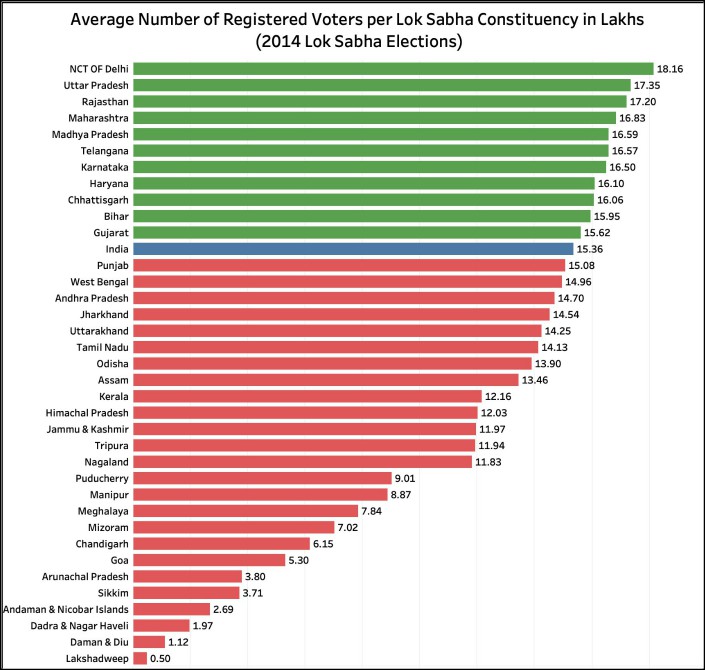
The lowest was in Lakshadweep where the number of registered voters was around 50000. The most number of voters in a constituency was in Malkajgiri from Telangana where the number of registered voters was 31.8 lakh in 2014. Out of the 543 constituencies, the average electorate size was more than the national average of 15.36 lakh in 293 constituencies.
Even the number of assembly constituencies is not uniform
Each Lok Sabha seat consists of a specific number of Assembly segments in States/UTs that have a legislative assembly. The number of such segments vary from state to state. In most big states, this number varies from 5 to 10 assembly segments per Lok Sabha seat. This number is very high in the North-Eastern and smaller states because of the lower population. The highest number of assembly segments for a single Lok Sabha seat is in Nagaland where all the 60 assembly segments in the state are part of the same Lok Sabha seat.
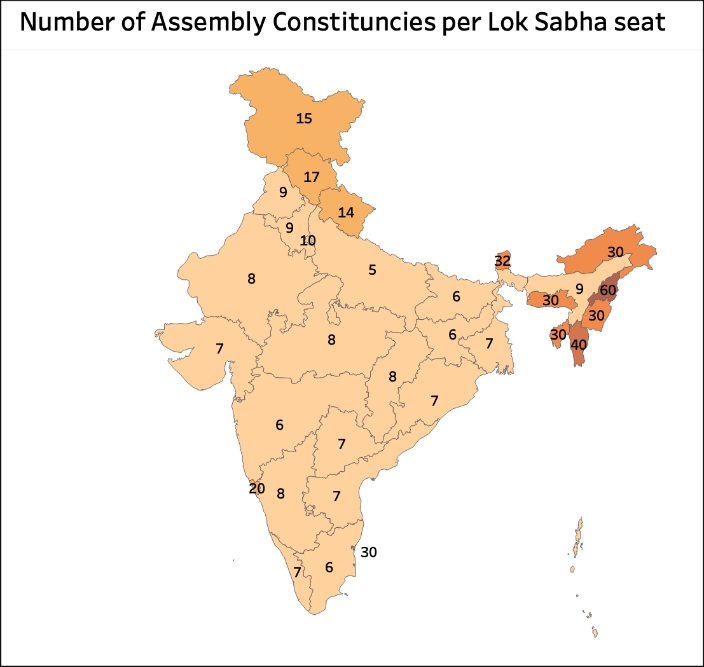
Is the number of Lok Sabha seats in a State fixed forever?
Every now & then, the government sets up a ‘Delimitation Commission’. According to the Election Commission of India (ECI), Delimitation literally means the act or process of fixing limits or boundaries of constituencies in the country or in states that have legislative bodies like the Lok Sabha or an assembly. Such a commission is expected to take note of changes in population in various areas and adjust the number of constituencies accordingly.
Till date, such commissions have been constituted four times. The last such commission was constituted in 2002 which redrew the boundaries of various Lok Sabha constituencies. But the 2002 exercise was limited to redrawing boundaries of constituencies within a state. It did not venture into readjusting the number of Lok Sabha seats allocated to each state.
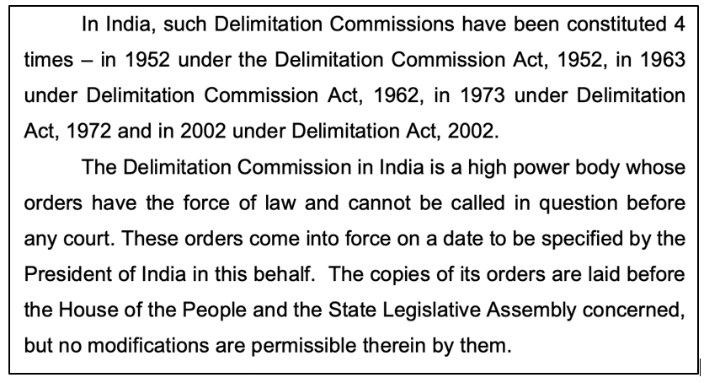
Why is there no readjustment of Lok Sabha seats after every Census?
As per Article 82 of the Constitution of India, there has to be readjustment of seats after each census (every 10 years) and such adjustment should be based on the population.
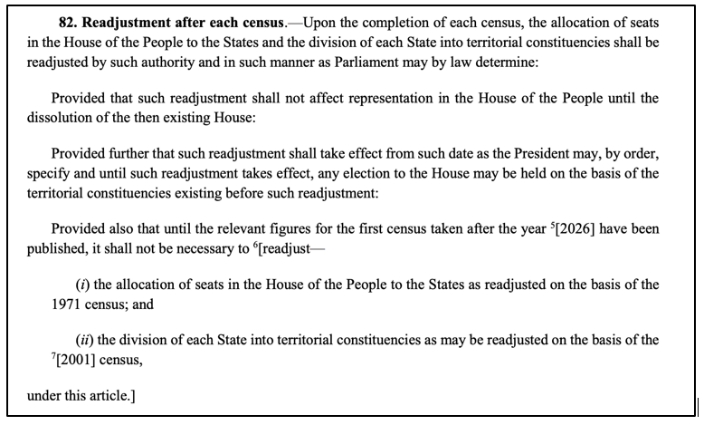
However, this was not done because of the 42nd amendment to the Constitution, more popularly known as the ‘Mini-Constitution’ that made widespread changes to the constitution during emergency days in 1976. ‘Population control and family planning’ was included in the concurrent list with this amendment. The government of the day was keen on promoting family planning and to control population growth.
Hence provisions were included in articles 55, 82, 170 and 330 of the constitution not to make any changes to the number of Lok Sabha seats, Assembly seats etc. until the figures from the first Census after the year 2000 have been published. This was done as a measure to boost family planning norms. In other words, any readjustment to the total number of seats had to take place only after the year 2000 when the 2001 Census figures would be published.
The NDA government extended this to 2026
The NDA government in the year 2001 felt the need to amend the provisions included through the 42nd amendment since the 2001 Census figures were about to be published. The statement of objects to the 84th amendment to the constitution in 2001 mentions that there have been consistent demands, both for and against undertaking the exercise of readjustment. It further says that considering the progress of family planning programs in different parts of the country, and as per the National Population Policy strategy, it was decided to extend the freeze on readjustment up to the year 2026. The government saw it as a motivational measure to encourage State Governments to pursue the agenda for population stabilization. Thus the embargo on any readjustment to the total number of seats was extended to 2026, meaning that any such readjustment can only be done after the 2031 Census.
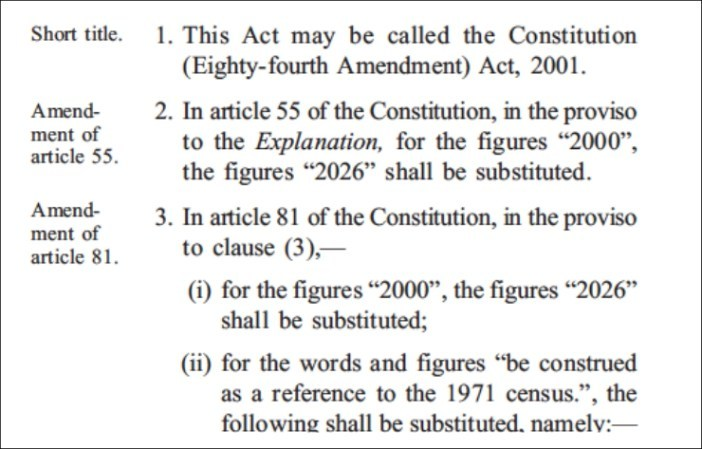
While readjustment or changing the number of seats is to be done only after 2026, the 84th amendment allowed delimitation (process of fixing limits or boundaries of territorial constituencies) or changing the reservation status of the constituencies after the 2001 Census. This was to be done without altering the total number of seats in a state. The Delimitation Act of 2002 served this purpose.
Is population growth uneven?
One of the prime reasons for freezing the readjustment of Lok Sabha/Assembly seats was to ensure uniform population growth in various states. If readjustment had to be done after each Census, states that have controlled population growth would have lost out on the number of Lok Sabha seats & also on the value of its votes in the Presidential election while the ones that did not control stand to benefit.
Even till 2001, most states had a decadal population growth rate between 20% & 30%. For the first time, between 2001 & 2011, the decadal growth rate for most states had fallen to between 10% & 20%. The number states growing over 30% had come down from 11 between 1981-91 to 3 between 2001-11.
While northern states like Bihar, Jharkhand, Rajasthan, Madhya Pradesh & Uttar Pradesh had a decadal growth rate over 20% in the 2001-11 period, southern states like Andhra Pradesh, Telangana, Kerala, Karnataka & Tamil Nadu grew at less than 16% in the 2001-11 period. Kerala in fact had the lowest growth rate of 4.9% in the 2001-11 period, which is 1/5th of Bihar’s growth rate. If the readjustment was done after every Census, the southern states would have lost out on the total Lok Sabha seats for doing better on population control while the northern states would have benefitted for not controlling population.
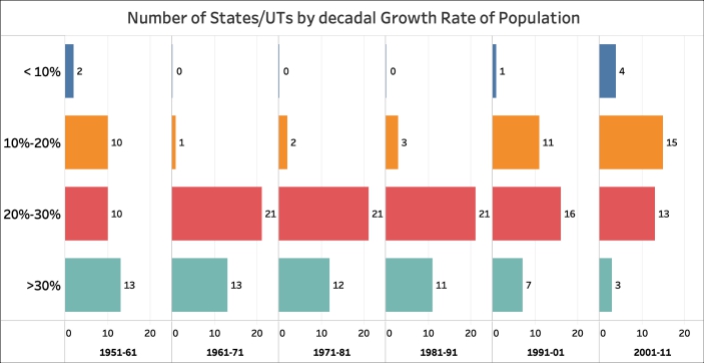
Will the readjustment take place after 2031?
While freezing the readjustment till 2026 made sense because of such uneven growth rates, it remains to be seen how the problem will be solved even after 2026, since the growth rates may not even out in the near future. It will also be interesting to see how the states that controlled population will be rewarded.


